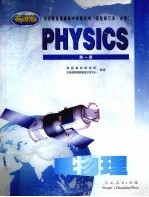

物理 第1册PDF电子书下载
- 电子书积分:11 积分如何计算积分?
- 作 者:课程教材研究所双语课程教材研究开发中心组编
- 出 版 社:北京:人民教育出版社
- 出版年份:2002
- ISBN:710715561x
- 页数:252 页
Preface 1
Mechanics 2
Chapter 1 Force 2
Ⅰ Force 3
Ⅱ Gravitational force 4
Ⅲ Elastic force 7
Ⅳ Frictional force 10
Readings Fluid resistance 13
Ⅴ Composition of forces 15
Ⅵ Resolution of force 17
Chapter 2 Rectilinear motion 22
Ⅰ Mechanical motion 23
Ⅱ The relationship between displacement and time 27
Ⅲ Description of speed of motion Velocity 29
Readings How to understand instantaneous velocity 30
Ⅳ The relationship between velocity and time 32
Ⅴ Description of the change of velocity Acceleration 34
Ⅵ Laws of uniform variable rectilinear motion 36
Readings An alternative derivation of the displacement equation 38
Ⅶ Application of the laws of uniform variable rectilinear motion 40
Ⅷ Free-fall motion 43
Readings How Galileo studied free-fall motion 46
Chapter 3 Newton's laws of motion 52
Ⅰ Newton s first law 53
Readings Einstein talked about the contributions of Galileo 55
Ⅱ Change in state of a motion 57
Ⅲ Newton's second law 59
Ⅳ Newton's third law 64
Ⅴ Unit system of mechanics 66
Ⅵ Application of Newton's laws of motion 68
Readings Measuring mass in a way of dynamics 71
Ⅶ Overweight and weightlessness 72
Readings Weightlessness and space exploitation 74
Ⅷ The inertial and noninertial systems 76
Ⅸ The applicability of Newton's laws of motion 79
Chapter 4 Equilibrium of objects 84
Ⅰ Equilibrium of an object acted on by concurrent forces 85
Ⅱ Application of the equilibrium condition of concurrent forces 86
Ⅲ Equilibrium with a fixed rotational axis 88
Ⅳ Application of the equilibrium condition of moments 91
Readings Kinds of equilibriums Stability 93
Chapter 5 Curvilinear motion 98
Ⅰ Curvilinear motion 99
Ⅱ Composition and resolution of motion 102
Ⅲ Motion of horizontally projected objects 105
Ⅳ Uniform circular motion 110
Ⅴ Centripetal force Centripetal acceleration 113
Readings The derivation of the equation of centripetal acceleration 116
Ⅵ Analysis of practical examples of uniform circular motion 118
Ⅶ Centrifugal phenomenon and its application 120
Chapter 6 The law of universal gravitation 126
Ⅰ Planetary motion 127
Ⅱ The law of universal gravitation 128
Ⅲ The measurement of gravitational constant 131
Ⅳ Applications of the law of universal gravitation in astronomy 133
Ⅴ Artificial satellite Cosmic velocity 134
Readings Black hole 135
Ⅵ Planets,stars,galaxies and the universe 137
Chapter 7 Momentum 142
Ⅰ Impulse and momentum 143
Ⅱ Theorem of momentum 146
Ⅲ The law of conservation of momentum 150
Ⅳ Applications of the law of conservation of momentum 153
Ⅴ Recoil motion Rocket 156
Readings The development of space technology and space flight 159
Chapter 8 Mechanical energy 164
Ⅰ Work 165
Readings Work done by a varying force 168
Ⅱ Power 169
Ⅲ Work and energy 171
Ⅳ Kinetic energy Theorem of kinetic energy 172
Ⅴ Gravitational potential energy 177
Ⅵ The law of conservation of mechanical energy 180
Ⅶ Applications of the law of conservation of mechanical energy 183
Ⅷ Bernoulli's equation 187
Chapter 9 Mechanical vibration 196
Ⅰ Simple harmonic motion 197
Ⅱ Amplitude,period and frequency 200
Ⅲ Graphs of simple harmonic motion 202
Readings Tone and scale 204
Ⅳ Simple pendulum 207
Ⅴ Phase 211
Readings The phase of the moon 214
Ⅵ The energy of simple harmonic motion Damped vibration 214
Ⅶ Forced vibration Resonance 216
Student's experiments 224
Ⅰ Measurement of length 227
Ⅱ Testing the parallelogram rule of force 231
Ⅲ Practice using the dotting timer 232
Ⅳ Analysis of uniform variable rectilinear motion 235
Ⅴ Analysis of projectile motion 238
Ⅵ Testing the law of conservation of momentum 239
Ⅶ Testing the law of conservation of mechanical energy 241
Ⅷ Analysis of the relationship between the elastic force and the stretched length of a spring 243
Ⅸ Measuring gravitational acceleration with a simple pendulum 244
Ⅹ Testing the law of conservation of momentum with the air cushion guide 245
Topic studies 248
1.Experiment:Analysis of the factors influencing sliding friction 249
2.Study report:Mechanical knowledge of a kitchen knife 249
3.Scientific and technical creation:Developing water"rocket" 249
4.Study report:The advantages and disadvantages of wheels held tightly during braking 249
5.Experiment:The relationship between the period of a spring oscillator and the mass of the ball 249
Appendix 250
Ⅰ Système International(SI) 250
Ⅱ Table of some English-Chinese terms 252
- 《全国高等中医药行业“十三五”创新教材 中医药学概论》翟华强 2019
- 《MBA大师.2020年MBAMPAMPAcc管理类联考专用辅导教材 数学考点精讲》(中国)董璞 2019
- 《中央财政支持提升专业服务产业发展能力项目水利工程专业课程建设成果 设施农业工程技术》赵英编 2018
- 《党员干部理论学习培训教材 理论热点问题党员干部学习辅导》(中国)胡磊 2018
- 《“十三五”规划教材 中药鉴定学实验 供中药学 药学及相关专业使用 第2版》吴啟南 2018
- 《危险化学品经营单位主要负责人和安全生产管理人员安全培训教材》李隆庭,徐一星主编 2012
- 《21世纪法学系列教材 配套辅导用书 行政法与行政诉讼法练习题集 第5版》李元起主编 2018
- 《高校转型发展系列教材 素描基础与设计》施猛责任编辑;(中国)魏伏一,徐红 2019
- 《全国校外艺术课堂新形态示范教材系列 少儿钢琴表演曲集》唐冠祥编著 2019
- 《全国学前教育专业(新课程标准)“十三五”规划教材 简谱手风琴教程 第2版》(中国)杨克勤,王宝庆 2019
- 《电子测量与仪器》人力资源和社会保障部教材办公室组织编写 2009
- 《现代水泥技术发展与应用论文集》天津水泥工业设计研究院有限公司编 2019
- 《培智学校义务教育实验教科书教师教学用书 生活适应 二年级 上》人民教育出版社,课程教材研究所,特殊教育课程教材研究中心编著 2019
- 《中国制造业绿色供应链发展研究报告》中国电子信息产业发展研究院 2019
- 《办好人民满意的教育 全国教育满意度调查报告》(中国)中国教育科学研究院 2019
- 《中国传统京剧故事绘本 追韩信》成都市京剧研究院,四川众木文化著;小狐仙动漫绘 2019
- 《近代中国分省人文地理影像采集与研究 甘肃》《近代中国分省人文地理影像采集与研究》编写组 2019
- 《系统解剖学速记》阿虎医考研究组编 2019
- 《2019国家医师资格考试用书 中医执业助理医师资格考试全真模拟试卷与解析 第3版》国家医师资格考试研究组 2019
- 《中国退役动力电池循环利用技术与产业发展报告》中国科学院过程工程研究所,资源与环境安全战略研究中心,中国物资再生协会编著 2019
- 《培智学校义务教育实验教科书教师教学用书 生活适应 二年级 上》人民教育出版社,课程教材研究所,特殊教育课程教材研究中心编著 2019
- 《指向核心素养 北京十一学校名师教学设计 英语 七年级 上 配人教版》周志英总主编 2019
- 《习近平总书记教育重要论述讲义》本书编写组 2020
- 《办好人民满意的教育 全国教育满意度调查报告》(中国)中国教育科学研究院 2019
- 《北京生态环境保护》《北京环境保护丛书》编委会编著 2018
- 《教育学考研应试宝典》徐影主编 2019
- 《语文教育教学实践探索》陈德收 2018
- 《家庭音乐素养教育》刘畅 2018
- 《学前教育学》王换成主编 2019
- 《近代体育游戏教育史料汇编 第1辑 1》王强主编 2016
